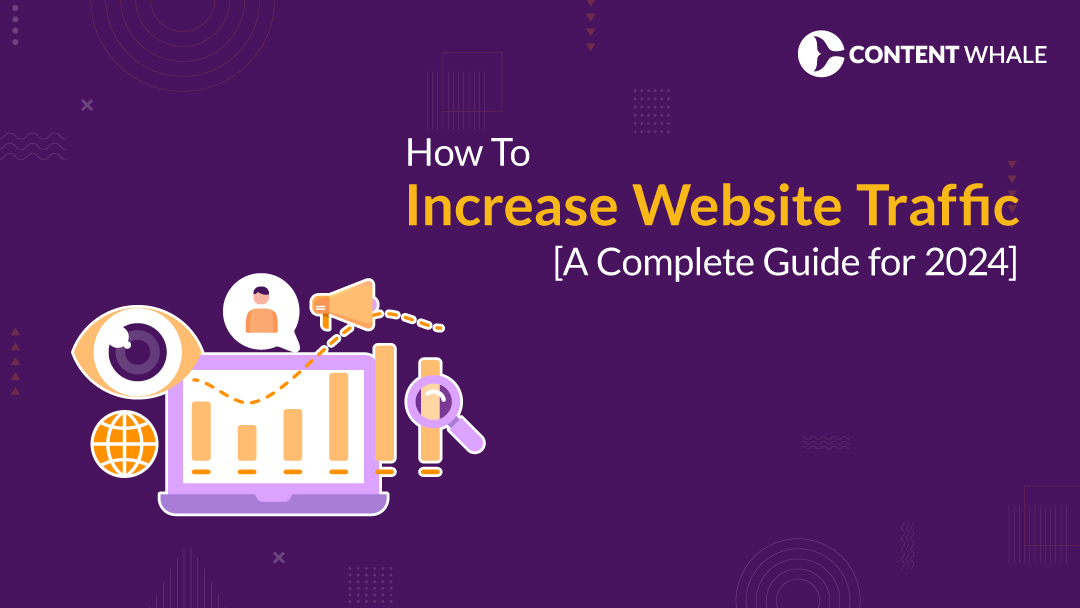Are you looking for the right strategy on how to increase web traffic? Or let’s put it this way – Are you looking to boost your website traffic significantly in 2024? You’re in the right place. Increasing website traffic is crucial for any business looking to grow online.
It’s not just about getting more eyes on your page; it’s about attracting the right kind of visitors who are interested in what you have to offer. Whether you’re a small business owner, a digital marketer, or a blogger, understanding how to increase website traffic is key.
In this guide, we’ll dive into proven strategies and the latest trends to help you drive more visitors to your site. Let’s get started on this journey to unlock the full potential of your website.
Understanding Website Traffic

What is Website Traffic?
Website traffic is the number of visitors who land on your website. It’s essential for the growth of any online presence. However, not all traffic is the same. Let’s break down the types:
- Organic Traffic: Comes from search engines like Google. It’s free and occurs when people find your site after typing a query.
- Paid Traffic: Involves paying for advertising to attract visitors. Common sources include Google Ads and social media ads.
- Direct Traffic: Occurs when someone enters your website URL directly into their browser. It indicates brand awareness or repeat visitors.
- Referral Traffic: Happens when a visitor comes to your site from another website that links to yours.
- Social Traffic: Originates from social media platforms. This traffic is driven by your content’s performance on platforms like Facebook, Twitter, or Instagram.
Why is Website Traffic Important?
More traffic means more opportunities to engage with potential customers. The equation is straightforward: more visitors can lead to more conversions, whether that’s sales, leads, or increased influence. However, the focus should be on attracting high-quality traffic—visitors genuinely interested in what you offer.
How to Increase Website Traffic?
To increase website traffic, start by understanding what your audience searches for online. Optimize your content for search engines, engage on social media, and create valuable content that meets your audience’s needs and interests. Attracting the right kind of traffic is key to converting visitors into loyal customers or followers.
Tools to Track and Analyze Website Traffic

To effectively increase your website traffic, you need the right tools to measure and understand your visitors. Here’s a look at some essential tools that can help you track your website traffic and gain valuable insights:
1. Google Analytics
- What it does: Tracks and reports website traffic, providing insights into visitor behavior, traffic sources, and content engagement.
- Why it’s important: It’s a comprehensive, free tool that helps you understand how users interact with your site, which is crucial for making informed decisions to boost traffic.
2. Visitor Queue
- What it does: Identifies B2B visitors, showing which companies visit your site, what pages they view, and how they found you.
- Why it’s important: It helps you generate leads by understanding which businesses are interested in your services, allowing for targeted follow-ups.
3. Semrush
- What it does: Offers tools for SEO, content marketing, competitor research, PPC, and social media marketing.
- Why it’s important: It provides insights into your site’s performance and your competitors’, helping you identify opportunities to increase traffic.
4. Hotjar
- What it does: Creates heatmaps of your site, showing where visitors click, scroll, and spend time.
- Why it’s important: Understanding user behavior on your site can help you make changes that improve user experience and retention.
5. Similarweb
- What it does: Provides analytics for your own site as well as competitor sites, including traffic sources and user engagement.
- Why it’s important: It gives you a broader view of your industry’s online landscape, helping you spot trends and opportunities to attract more visitors.
6. LogRocket
- What it does: Records sessions showing how users interact with your site, identifying usability issues.
- Why it’s important: By spotting and fixing user experience issues, you can improve site performance and visitor satisfaction.
Each of these tools offers unique insights that can help you understand how to increase website traffic. By leveraging these tools, you can make data-driven decisions to optimize your site and attract more visitors.
SEO Best Practices for Increasing Website Traffic

Boosting your website traffic hinges on your SEO strategy. Here’s what you need to focus on, explained differently:
1. Match Your Content with Search Intent
Understanding what your audience is searching for and tailoring your content to meet those queries is crucial. This approach ensures your content is exactly what search engines want to serve up.
2. Keyword Optimization Is Key
Integrating relevant keywords throughout your site, from blog posts to your page titles and meta descriptions, makes your content discoverable. It’s not just about stuffing keywords; it’s about placing them smartly where they have the most impact.
3. Prioritize High-Quality Content
The cornerstone of any successful SEO strategy is valuable content. Creating pieces that provide real value to your audience will not only help with engagement but also encourage shares and backlinks, which are gold for SEO.
4. Speed Up Your Site
A fast-loading website enhances user experience and is favored by search engines. Regularly check your site speed and make necessary adjustments to keep your pages loading quickly.
5. Make Your Site Mobile-Friendly
With more people browsing on mobile devices, having a website that’s optimized for mobile is non-negotiable. A mobile-friendly site improves user experience and boosts your rankings in mobile search results.
6. Leverage Internal Linking
Strategically linking to other pages within your site helps search engines crawl your site more effectively and distribute page authority across your website, improving your overall SEO.
7. Build Quality Backlinks
Earning backlinks from reputable sites indicates to search engines that your content is valuable and trustworthy, significantly boosting your SEO.
8. Keep Content Fresh and Updated
Regularly updating your content keeps it relevant and may give it a second chance to rank higher in search results. It shows search engines that your site is active and providing up-to-date information.
Implementing these SEO best practices will not only help increase your website traffic but also improve your site’s overall health and performance in search rankings.
5. Make Your Site Mobile-Friendly
With more people browsing on mobile devices, having a website that’s optimized for mobile is non-negotiable. A mobile-friendly site improves user experience and boosts your rankings in mobile search results.
Content Strategy for Traffic Generation

In 2024, to increase website traffic, your content strategy needs to be smart and adapt to the latest trends. Here’s a streamlined approach:
- Social Media as a Tool: Beyond posting, use social media for search and customer service. Sharing expert advice and solutions can make your brand a go-to resource, helping increase website traffic.
- Balance Personalization and Privacy: Use the data you have to personalize content without overstepping privacy boundaries. Clear, respectful data use can boost trust and traffic.
- Use AI Smartly: AI tools can help with creating content faster. They’re great for coming up with ideas and drafting posts, which means you can publish more content and increase traffic.
- Align Content with Sales: Make sure your content helps move leads down the sales funnel. Integrating content strategy with CRM tools ensures everyone is on the same page, potentially increasing traffic and conversions.
- Efficiency is Key: Automate where you can. AI can save time on routine tasks, letting you focus on creating content that attracts more visitors.

As we’ve navigated through the essential strategies and pitfalls to avoid, remember that the core of successful blogging remains unchanged: delivering value to your audience.
By staying ahead of SEO trends, optimizing for emerging technologies like voice search, and ensuring your content is both engaging and accessible, you’re setting your blog up for success.
Embrace the changes, leverage the tools at your disposal, and always keep your reader’s needs at the forefront of your strategy.
The future of blogging is bright for those willing to adapt, innovate, and engage with their audience on a deeper level.
Let’s move forward with these insights, ready to make an impact with our content in 2024 and beyond. And if any point in time, you need professional blog writing services that are affordable and deliver guaranteed rankings, you are always welcome to contact us!
Q.How can I get more traffic to my website?
A. There are many ways to increase your website traffic, but some of the most effective ones are:
- Optimize your content for search engines and users.
- Create and promote high-quality content.
- Build links from authoritative and relevant websites.
- Improve your site speed and user experience.
Q. What is a good increase in website traffic?
A. Website traffic is the number of users who visit your website. It is an important metric to measure the performance and growth of your site.
However, not all traffic is equal. You want to attract visitors who are genuinely interested in your content and offerings, and who will engage with your site and take action. This is called organic traffic, and it comes from users who find your site through search engines without clicking on paid ads.
The amount of organic traffic you can get depends on many factors, such as your niche, your audience, your content quality, your SEO strategy, your competitors, and more.
Therefore, there is no one-size-fits-all answer to what is a good increase in website traffic. However, some general guidelines are:
- Aim for a realistic and sustainable growth rate. Increasing your web traffic drastically might seem appealing, but slow and steady wins the race for increased web traffic that’s sustainable.
- Once you’ve analyzed your domain’s current traffic, set a goal to increase that number by no more than 20% each month – better yet, aim for 10%.
- Focus on the quality and relevance of your traffic, not just the quantity. Content that relies on trending news will only get you short-term traffic. Creating unique and epic content, on the other hand, is key to organically increasing website traffic. This type of content should be valuable, informative, and entertaining – as well as relevant to your audience’s pain points.
- Use different methods and channels to drive traffic to your website. There are many ways to increase your website traffic, such as creating more content, optimizing your content for SEO, guest blogging, hosting external guest bloggers, recycling content for use across multiple channels, blogging for short-tail and long-tail keywords, interlinking to other pages on your website, building links from authoritative and relevant websites, improving your site speed and user experience, creating and promoting high-quality content, adding FAQ sections to your pages, adding FAQ schema to your pages, and more.
- Track and measure your traffic growth and sources. Use tools like Google Analytics, Ahrefs, Moz, or Geckoboard to monitor your website traffic metrics, such as page views, sessions, bounce rate, conversion rate, traffic source or type, and more.
- These metrics will help you understand your user behavior and engagement patterns, identify your most viewed and least viewed pages, find out where your traffic is coming from and what keywords they are using, and evaluate the effectiveness of your marketing strategies and campaigns.
- You can also use these tools to set and track your traffic goals and compare your performance with your competitors.





